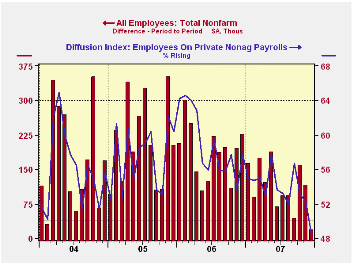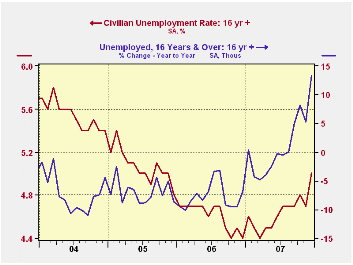 Global| Jan 04 2008
Global| Jan 04 2008U.S. Payrolls Weak, Unemployment Rate Surged
by:Tom Moeller
|in:Economy in Brief
Summary
For December, the Bureau of Labor Statistics reported that nonfarm payrolls rose a meager 18,000 versus expectations for a 50,000 increase. That expectation was ratcheted down after yesterday's ADP report of a modest 40,000 increase [...]

For December, the Bureau of Labor Statistics reported that nonfarm payrolls rose a meager 18,000 versus expectations for a 50,000 increase. That expectation was ratcheted down after yesterday's ADP report of a modest 40,000 increase in private nonfarm payrolls.
The December increase was the weakest since 2003. It was accompanied by a slight upward revision to the gain in November jobs but a downward revision to October.
Private industries payrolls fell 13,000 (+0.9% y/y), the first monthly decline since 2003.
Perhaps portending further weakness in payroll jobs was a drop in the one month diffusion index of job gain. At 48.4% this measure of the breadth of job growth amongst industries was at its lowest and below 50 for the first time since 2003.
The unemployment rate surged to 5.0% last month from 4.7% in November. Household employment fell 436,000 (0.2% y/y and reversed most of November's 631,000 surge. The ranks of the unemployed grew 474,000 (13.2% y/y) and the labor force rose just 38,000 (0.8% y/y) after a 522,000 November jump. The labor force participation rate held steady at 66.0%, down from the 66.2% averaged last year.
The level of average hours worked has remained notably stable recently. As a result, the 4Q level of aggregate hours worked (employment times hours) rose just 1.0% (AR) following a 3Q rise of 1.2% and a 2.1% increase during 2Q. During the last ten years there has been a 44% correlation between the gain in hours and the gain in real GDP. That correlation is down from 56% over the last 20 years and from 74% over the last 30 due to the faster growth in worker productivity.
Factory sector payrolls fell another 31,000, the largest decline since August. Construction employment fell out of bed and posted a 49,000 drop last month which was the largest since February.
Continuing the shortfall in last month's job gain was the modest 62,000 rise in private service sector employment (1.5% y/y). That was half the November gain and the weakest since 2005. Retail employment fell 24,000 (+0.3% y/y) while jobs in finance fell 4,000 (-0.2% y/y), the sixth decline in the last seven months. Jobs in clothing stores fell 7,900 (+0.4% y/y) and temporary help services jobs were unchanged (-1.7% y/y).
Firm were job gains in the health care sector which rose 36,900 (3.2% y/y). Professional & business services rose 43,000 (1.8% y/y).
Employment in the government sector also rose a moderate 31,000 (1.2% y/y) after a 28,000 worker increase in November. Jobs with the Federal government fell 4,000 (-0.2% y/y).
Average hourly earnings increased 0.4% and the prior month's gain was revised up slightly. Factory sector earnings reversed all of the prior month's gain with a 0.5% decline (+2.6% y/y). Private service-providing earnings rose 0.5% (4.1% y/y).
| Employment: 000s | December | November | October | Y/Y | 2007 | 2006 | 2005 |
|---|---|---|---|---|---|---|---|
| Payroll Employment | 18 | 115 | 159 | 1.0% | 1.3% | 1.9% | 1.7% |
| Previous | -- | 94 | 170 | -- | -- | -- | -- |
| Manufacturing | -31 | -13 | -23 | -1.5% | -1.2% | -0.2% | -0.6% |
| Construction | -49 | -37 | -20 | -2.5% | -0.8% | 4.8% | 5.2% |
| Average Weekly Hours | 33.8 | 33.8 | 33.8 | 33.9 (Dec '06) | 33.8 | 33.8 | 33.8 |
| Average Hourly Earnings | 0.4% | 0.4% | 0.2% | 3.7% | 3.9% | 3.9% | 2.8% |
| Unemployment Rate | 5.0% | 4.7% | 4.8% | 4.4% (Dec '06) | 4.6% | 4.6% | 5.1% |
Tom Moeller
AuthorMore in Author Profile »Prior to joining Haver Analytics in 2000, Mr. Moeller worked as the Economist at Chancellor Capital Management from 1985 to 1999. There, he developed comprehensive economic forecasts and interpreted economic data for equity and fixed income portfolio managers. Also at Chancellor, Mr. Moeller worked as an equity analyst and was responsible for researching and rating companies in the economically sensitive automobile and housing industries for investment in Chancellor’s equity portfolio. Prior to joining Chancellor, Mr. Moeller was an Economist at Citibank from 1979 to 1984. He also analyzed pricing behavior in the metals industry for the Council on Wage and Price Stability in Washington, D.C. In 1999, Mr. Moeller received the award for most accurate forecast from the Forecasters' Club of New York. From 1990 to 1992 he was President of the New York Association for Business Economists. Mr. Moeller earned an M.B.A. in Finance from Fordham University, where he graduated in 1987. He holds a Bachelor of Arts in Economics from George Washington University.






